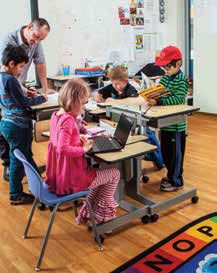STANDING UP FOR LEARNING

A new study by Ranjana K. Mehta , Ashley E. Shortz, and Mark E. Benden from the Department of Environmental and Occupational Health, Texas A&M School of Public Health, examines improvements in executive functioning and working memory and explores associated changes in frontal brain function.
Thirty-four freshman high-school students were recruited for neurocognitive testing at two points during the school year—in the fall semester and again in the spring semester, after using standing desks continuously for 27.57 weeks.
The researchers evaluated the students’ executive function and working memory using a computerized neurocognitive test battery, and they measured brain activation patterns of the prefrontal cortex with functional near-infrared spectroscopy. Continued use of the standing desks was associated with significant improvements in executive function and working memory capabilities. The researchers also observed changes in corresponding brain activation patterns.
These results make an important first contribution to the existing knowledge base regarding the relationships between physical activity, basic cognition, and brain function in adolescents.
FOR THE FULL STUDY GO TO WWW.TECHLEARNING.COM/MAY16
Tech & Learning Newsletter
Tools and ideas to transform education. Sign up below.











